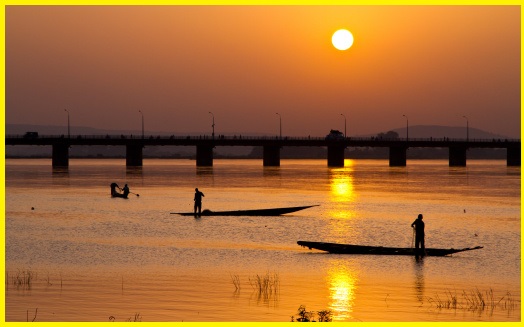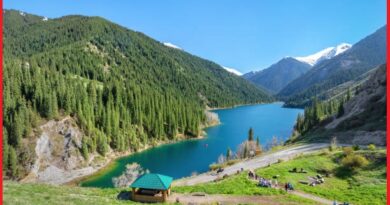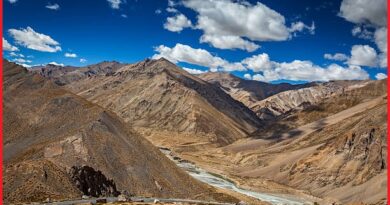Niger River-The 3rd Longest River of Africa, Know its Origin Place
Niger River
The Niger River stretches 4,100 km in length, and is the third longest river in Africa, after the Nile and the Congo. It is located in West Africa and runs in a long crescent from Guinea to Mali, right up to the edge of the Sahara desert, before heading south to the Gulf of Guinea in the Atlantic ocean. The river is named the County Niger where it flows the major part of its. The source of the river rises in the Fouta Djallon Highlands at a point near the border between Guinea and Sierra Leone, 241 km from the Atlantic coast. Niger, Guinea, Cote de Ivoire, Mali, Burkina Faso, Algeria, Benin, Chad, Cameroon, and Nigeria are the ten African countries that the Niger river runs through. Its main tributary is the Benue River. The drainage basin of the river encompasses 2,090,000 square km.
History
The first European to discover the Niger River was Mungo Park in the 1790s. Mali’s capital, the city of Bamako, was built on both sides of the Niger River. The city came to be in existence in the 19th Century, It was then a tiny village with a few local residents, but it grew over the years, due to the Niger River’s resources. The river was used for transportation, fishing, market gardening, sand extraction, and as a trade route. Niger river map- Niger river on the map shows the arcuate shape and major country located on its bank.

Geography
The main source of the Niger River is called the Tembi River. Away from the source but within Guinea, several tributaries join and replenish the Niger. The Niger river traverses the interior plateau in a northeast direction toward the Malian border. As the Niger crosses the border between Guinea and MALI, other rivers such as the Fie join the main river near Kangare, Mali. From here Niger flows northeasterly until it reaches the interior delta in Mali. In this delta, Niger is joined by the Bani River, which is an important tributary of Niger. The Bani River is 1,120 km long and has its source in COTE D’IVOIRE and BURKINA FASO.
Also read- Puerto Rico Tourism: 5 Best Geological Natural Sites
Niger river is a lifeline of western Africa, especially Mali. It provides fish, most of the water, and resources and represents a major means of transportation in Mali, particularly in some of the remote areas in the country. From this interior delta, the river flows in a northeast direction before turning to the southeast to form the great bend. From here Niger slowly meanders into the arid areas in proximity to Gao and enters the country of NIGER.
The Niger River then continues and forms the boundary between the Republic of Niger and Benin. This part of the Niger receives the Mekrou, a tributary from Benin. Thereafter, the river enters the Federal Republic of Nigeria, where the Benue River joins at Lokoja in Nigeria. From the confluence with the Benue, the Niger heads southward and discharges through a massive delta 9Niger Delta) into the Gulf of Guinea.

Niger river delta
The Niger delta stretches for nearly 240 km from north to south and spreads along the coast for about 320 km, extending over an area of 36,000 square km. Within the delta, the river breaks up into an intricate network of channels. The mouths of these channels are almost all obstructed by sandbars. The Nger river delta is being gradually extended seaward by the increments of silt brought down by the river, and mangrove swamps extend beyond its outer edge.
There are different types of habitats along the flows of the Niger River. These habitats are diverse with flora and fauna supporting people and their livestock. The swamps, lakes, and delta channels consist of numerous migratory wetland bird species. Mammals include West African manatees and Pygmy hippos. Waterfowl, herons, spoonbills, Black-crowned cranes, and ibises are other bird species spread across the vast Niger River Basin. Grasses like Acroceras, Amplectens, Echinochloa pyramidalis, and Erasgrostis atroviriens are found in the low-lying floodplains of the Niger River Delta.
Tourism attraction of Niger
Places of travel in Niger are diverse, from cultural attractions to desert empires that have some of the wild and wonderful natural beauty, that many potential travellers would expect from an African country. Some best nature sights are relatively close to Niamey, the capital of Niger. Visitors can see the rich culture of the Sahel region, One needs to head east and north of the capital to reach the great Sahara Desert.

Ayorou
Ayorou is a picturesque town on the banks of the Niger River, almost at the point where Niger borders Mali to the north. The most popular activity to do in Ayorou is to go on a hippopotamus tour on the river. The tour will also take to the travellers a couple of the inhabited islands on the river so one can experience village life. Ayorou is about north of Niamey and is easily reached from the capital.
Zinder
Zinder is often referred to as the cultural capital of Niger, It was the capital until 1927 when the capital was moved to its current location of Niamey. The city offers plenty of attractions for tourists, including the Sultan’s Palace, which is made from mud brick. It is uniquely stylized to the traditions of the Sahel region. A large market here offers a glimpse into the mercantile past, and the traditions that continue in this part of the world.
Niamey
Niamey is the capital of Niger, Situated on the banks of the Niger River. The river is named after the County Niger. It is situated in a place where the river flows gently. Niger is famous for the best hospitality and entertainment options and plenty to do in Niamey, such as visiting the colossal Grande Mosque. The structure is a testament to Niger’s huge Muslim population, which makes up over 90 percent of the total. Visiting Cathedral de Maorey is an interestingly best experience, it mixes European and African styles.
W National Park
W National Park is a protected parkland shared across a tri-border area between the nations of Niger, Benin, and Burkina Faso. The Park is declared a UNESCO World Heritage site in 1996. A big area of the park lies within Niger and was established in 1954. The Park is notably home to large mammals, including some of the last African elephants left in West Africa. Baboons, water buffalo, hippos, cheetahs, leopards, and lions, other animals in the park. The park is named so because the river Niger meanders, forming the letter ‘W’ from an aerial view.



